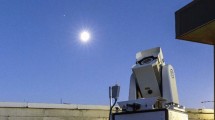Abstract
A preliminary study aimed at estimating the potential of a promising orbital lidar for space debris monitoring has been performed. Estimates of the space debris detection range under different observation conditions with different technical characteristics of lidar have been calculated. It is shown that the detection range for space debris fragments with sizes of 1 to 10 cm in the wavelength range near 0.5 µm depends strongly on the observation conditions, which are determined by the additive-noise level. It is concluded that a promising orbital lidar should contain a laser emitter with a power of several hundreds of watts and a receiving telescope about 0.5 to 1m in diameter. The possibility of using an orbital lidar for recognizing space debris is estimated. It is shown that a recognition probability exceeding 0.8 can be attained for a space debris image containing several tens of pixels and a signal-to-noise ratio above 10.
Similar content being viewed by others
References
A.M. Mikisha, L.V. Rykhlova, and M.A. Smirnov, “Space Contamination,” Vestnik Ross. Akad. Nauk. 71(1), 26 (2001).
C. Cappelletti, F. Guarducci, F. Paolillo, L. Ridolfi, M.L. Battagliere, F. Graziani, F. Piergentili, and F. Santoni, “Microsatellites Formation Flying for In-Situ Space Debris Detection,” Electron. J. “Trudy MAI,” Iss. 34 (2009) (www.mai.ru/science/trudy).
V.M. Zakharov, O.K. Kostko, L.I. Barich, M.G. Kruchenitskii, and V.S. Portasov, Laser Probing of Atmosphere from Space, Ed. by V.M. Zakharov (Gidrometeoizdat, Leningrad, 1988) [in Russian].
I.N. Matveev, V.V. Protopopov, I.N. Troitskii, and N.D. Ustinov, Laser Ranging, Ed. by N.D. Ustinov (Mashinostroenie, Moscow, 1984) [in Russian].
N.D. Ustinov, I.N. Matveev, and V.V. Protopopov, Methods for Processing Optical Fields in Laser Ranging (Nauka, Moscow, 1983) [in Russian].
Radar Handbook. Vol.1: Fundamentals of Radar, Ed. by M.I. Skolnik (McGraw-Hill, N.Y., 1970).
K. Gamal, “Status and Prospects of Using Satellite Laser Ranging Technique,” Sov. J. Quantum Electron. 6(5), 629 (1976).
Yu.S. Denishchik, “Analysis of the Modern State of Laser Ranging of Space Objects and Optimal Design of Lidar Systems,” in Collected Works of DonGTU (Izd-vo DonGTU, Alchevsk, 2007). Iss. 24, p. 329 [in Russian].
M.S. Malashin, Yu.B. Kaminskii, and Yu.B. Borisov, Fundamentals of Designing Lidar Systems (Vysshaya Shkola, Moscow, 1983) [in Russian].
O. Vovk, “Infrared Imagers in the Market of Guard Systems,” Algoritm Bezopasnosti. No. 21, 22 (2010).
V.N. Fomin, V.M. Nikitin, and E.G. Kolomiitsev, Optoelectronic Astrophysical Observations under Noisy Conditions (Izd-vo MGU, Moscow, 2012) [in Russian].
L.Z. Kriksunov, Handbook on the Bases of Infrared Engineering (Sov. Radio, Moscow, 1978) [in Russian].
The Infrared Handbook, Vol.1: Physics of Infrared Radiation, Ed. by W.L. Wolfe and G.J. Zissis (IRIA Center, Environmental Research Institute of Michigan, Washington DC, 1978).
V.M. Nikitin, V.N. Fomin, A.I. Nikolaev, and I.L. Borisenkov, Adaptive Noise Protection in Optoelectronic Information Systems (Izd-vo BelGU, Belgorod, 2008) [in Russian].
Ya.D. Shirman, Resolution and Compression of Signals (Sov. Radio, Moscow, 1974) [in Russian].
V.M. Nikitin, S.G. Garanin, and V.N. Fomin, Adaptive Noise Protection of Optoelectronic Sensors (for Control and Navigation Systems) (Izd-vo MGU, Moscow, 2011) [in Russian].
Author information
Authors and Affiliations
Corresponding author
About this article
Cite this article
Garnov, S.V., Moiseeva, A.V., Nosatenko, P.Y. et al. Estimation of the characteristics of a promising orbital lidar for space debris monitoring. Phys. Wave Phen. 22, 95–102 (2014). https://doi.org/10.3103/S1541308X14020034
Received:
Published:
Issue Date:
DOI: https://doi.org/10.3103/S1541308X14020034




